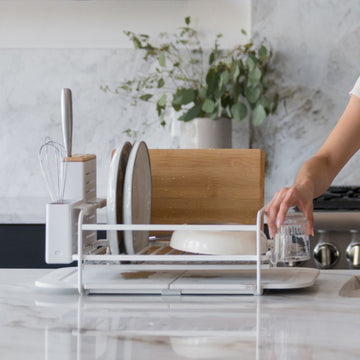Have you ever found yourself feeling completely overwhelmed by life or paralyzed by anxiety? Well you’re not alone, we have too, along with 1 in 5 other Americans. In fact, anxiety disorders are the most common mental illness in the U.S., affecting 40 million adults age 18 and older, or 18.1% of the population every year*. Further, Millennials are the most anxious generation according to new research, which shows stress levels among Americans have spiked sharply in the past year.

Mental health is a hugely important issue. From a personal perspective we believe this topic needs a more open dialogue to help reduce any lingering stigmas. We hope by having these conversations others realize they are not alone, and there are a variety of tactically-helpful approaches available. Mental health is complex, it’s not as simple as taking a pill. It’s a daily struggle that often requires a more holistic approach that may include medication, therapists, life coaches, and meaningful lifestyle changes. This blog post focuses on one aspect of a more comprehensive approach.
Our attention is stretched more than ever before with increasing professional expectations, and the demands of managing our relationships and homes. Not to mention our habitual engagement with our devices and the addictive nature of social media. I frequently find myself going into an anxious thought vortex when questioning the feasibility of keeping up with modern expectations, which is why I was grateful for the opportunity to sit down with Jamie Tabish and pick her brain.

Jamie Tabish is an Executive Functions Coach who helps individuals to create and implement functional structure and time management. She works with clients from a variety of backgrounds to identify the barriers that are getting in the way of things, and create a more usable system that reflects how the brain works. It was refreshing to hear her perspective from working with individuals with ADHD, anxiety, depression and recovery to learn how she adapts her process for each client to create a more sustainable and ownable outcome.
What are some of the common challenges you see young professionals facing in today’s world?
“There’s a chronic element of anxiety and depression that’s associated with this constant drive for success, without being able to define what that looks like. When I was in college there were established social norms, gender roles and rules that gave us context to understanding our world and choices, albeit limited and lacking social technology, it was easier to navigate, now it’s so open-ended people are unable to sift through it and navigate what success means in their life.
To add to this, we all live in a state of distraction. We’re so busy working, raising families, maintaining friendships, and engaging with our devices that in our pursuit towards achievement, we’re asking the wrong questions. We should be asking “why do I want to achieve something, instead of how”.
We’re lacking the healthy boundaries for work, family and friendships that provide us the freedom and independence to explore what we genuinely want and the purpose behind our actions. This all culminates in a lack of internal awareness.”
We can absolutely relate to this, especially when you mix business with relationships it’s essential to not only practice being more purpose-driven and self-aware, but to communicate the reason behind choices or emotions.
What are some other ways a lack of self-awareness negatively impacts us?
“It leaves many people feeling unfulfilled. Let me give you a relatable example: you go to college, you get a good job, you do all the things you were told to do, but eventually you realize where you are isn’t working for you. Then there’s resentment because you are not happy or fulfilled yet you did as you were ‘told’. So the next step is how do we learn to navigate from external validation to internal validation in regards to decision making.
Instead of continuing down this path of external validation, you need to explore what aspects aren’t working for you. What things do you need to keep and what do you need to toss out? It’s not overnight, it’s an ongoing process of developing self-awareness, trying things, gathering feedback and making adjustments to your path forward. We need to allow ourselves to evolve and change, even if that means breaking away from the conventional expectations.”

How do we improve our self-awareness?
“Start by making the distinction between doing and being. Doing is all the things we are engaged in. Being is existing in a state of awareness. It’s a different way of living that requires reflection, mindfully breaking things down, and taking the time to be honest with yourself.
Try this, make a list of all the things you feel responsible for, all your to-dos, obligations, etc. Then break that down and group them into categories that make sense for your life.
Then we shift to more of the ‘being’ state. After you sort into categories, start asking why. Why does this belong to you, why do you have to use your time to do this? Take each item on the list and ask, is this making me happy? If it’s a yes, then do it. Don’t overthink it. If it causes you to have a conversation about it or justify it, then there’s no need to hold onto it.” (We dive more concretely into this process at the end of this article).

How does being more self-aware help to reduce the negative mental chatter and anxiety we feel, and move us towards a more fulfilling life?
“It helps us create a better choice architecture and think more fluidly. The more clear and grounded you become around who you are, the easier it is to navigate life in a way that’s more true to you. This may be in opposition of what you’ve done in the past, which is letting the world or other people dictate how you spend your time or determine your options.
We’ve been so heavily influenced by external validation and moving through the endless societal structures that we’re not doing things for joy. You’ll never learn what’s best for you unless you experience, try new things, and gather data. When you become more aware of the things you like or don’t like, you start to understand yourself better and can think and process from that lens.
A more in-depth audit of how you spend your time and why will help you create healthy boundaries because you have the agency to say yes or no with confidence when things are being asked of you. You can’t add to your life if it’s already bogged down with expectations.”
This is so helpful. We can absolutely relate. In starting a company there’s a blurred boundary between work and personal, and if you’re not continuously practicing awareness and determining where to focus your thoughts, time, and attention it can quickly lead to endless feelings of overwhelm.

Can we go through an example of how you work with a client who is struggling with anxiety and overwhelm in their life?
Yes, It’s amazing how the process I’ve used for over 20 years as an organizer can be mapped to behavior change in other areas of life.
Step 1: Write down all the thing you’re worried about and thinking about. The dinner, taxes, work projects, obligations, etc. get it all out on paper.
Step 2: SORT - We’re not problem solving, we’re putting things in general categories: work relationships, family, self.
Step 3: TOSS - Ask yourself, is that something that needs to happen today, is it critical? Work your way through each item. Anything you want to keep from these general categories, we pull out and make a new list. If there are items that aren’t essential for your life or important for today, toss. Typically when we get to this point, we’re better able to identify what’s creating anxiety and causing overwhelm. When we get under the surface layer, it’s not usually what you think it is. Usually the anxiety is caused by an association with something else rather than what’s next.
Step 4: KEEP - We’re working with what stays, why, and how to prioritize it. Going back to the self-awareness piece, you’re left with the items you’ve made an informed choice about. Then ask, what is due or needs to happen today? Take time to break it down and process, why it’s important to do, and what are steps moving forward.
Step 5: DO - Now here’s your game plan, and you have a structure for how to go about decision making in being more self-aware. From the list of action items you can determine, what belongs to me and what belongs to others. Listen for feedback, evolve, and ask for help along the way.
When we’re clear minded we’re better at doing, and then assessing what’s working and what’s not.”
Thanks for sharing your wisdom with us Jamie! It was a joy to learn from your process. We’ve been practicing more self-awareness, boundaries, and informed decision making, and can say it’s been helpful during these intense few weeks. So much of this goes back to developing a better understanding of our core values, and being less reliant on external validation. There’s a lot of pressure and expectations that come with the fast-paced modern life, and we always appreciate learning from experts who help us aspire towards a more fulfilling existence.
You can learn more about Jamie or get in touch with her on her website, Organize by Design.





